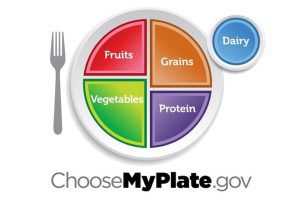We live in an era of supersize portions, which are largely responsible for the serious increase in cardiovascular diseases and obesity. When we talk about prevention, we must incorporate simple and didactic methods so that people with poor eating habits can calculate the right amount of food they need, no more no less.
The best thing to preserve health is to serve small portions, something we can do by guiding ourselves with the methods we are presenting today. They are easy to understand and follow and all without weighing or counting calories.
- Plate Method: all the nutrients in the same space.
This concerns dividing the plate (lunch or dinner) into two halves, which in turn divide into two portions and present it as follows:
- In the first half go fruit and vegetables. Vegetables, raw as well as cooked, take up more room than fruit, given that fruit generally has a higher sugar content.
- The second half of the plate is also divided into two quarters. The first, somewhat bigger, will consist of carbohydrates: mainly pasta, rice, potatoes and legumes. The other, smaller, half will be composed of protein foods such as meat, fish and eggs.


- The hand method: using our hands as a guide
This model is an effective way to teach eating according to the size of the portions, based on the idea that hands, being proportional to body size, show the amount of energy and food we need. The portions correspond to the following pattern:
- Vegetables: both hands together and open.
- Fruit: that fits on an open hand, in the form of a bowl.
- Carbohydrate (pasta, rice, bread, potatoes and cereals in general): a clenched fist.
- Protein: the portion of meat or fish is shown by the palm of the hand, the thickness corresponds to the little finger.
- Cheese: the portion corresponds to the firts phalanx of the thumb.
- Fat (oils and butter): The size of the first phalanx (tip) of the index finger.
In addition, the 5 fingers of the outstretched hand remind us that the daily intake should be distributed in 5 meals a day and that the number of recommended servings of fruit and vegetables is also 5.

Both methods have, as they all do, their limitations as they only refer to size without considering the nutritional and calorific value of food. So, if what is intended is to lose weight, you should take into account that it is not the same eating a serving of turkey as it is eating lamb for example, although they are the same size.
The aim of these methods is not to lose weight, but eat with common sense. Remember that we have to take care of the type of foods we choose and the variety of them. A process of change that is part of improving healthy habits.
Sources and further information:
https://www.hsph.harvard.edu/nutritionsource/healthy-eating-plate-vs-usda-myplate/
